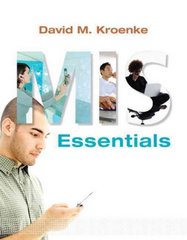Apply strategic goal setting to your ongoing professional growth
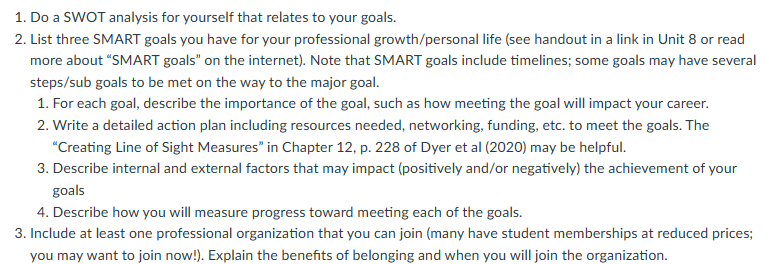
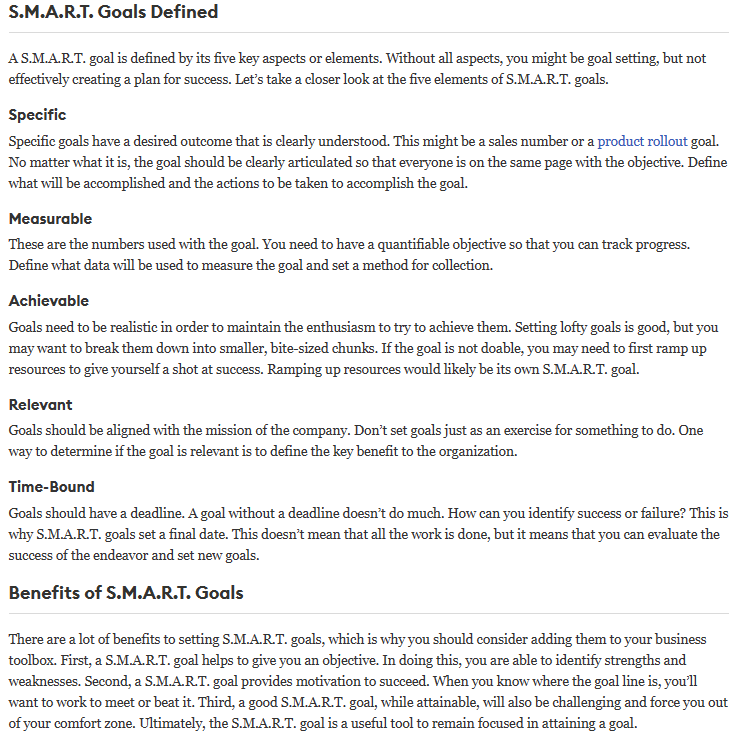
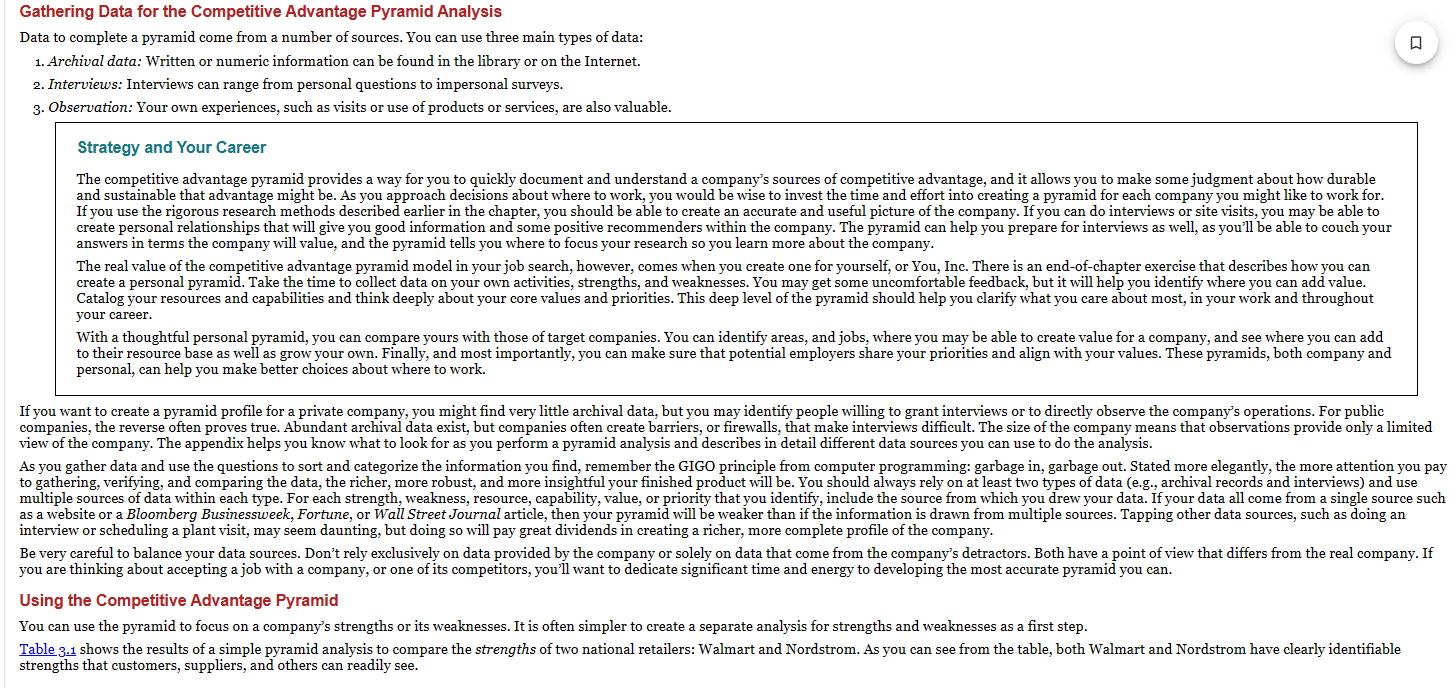
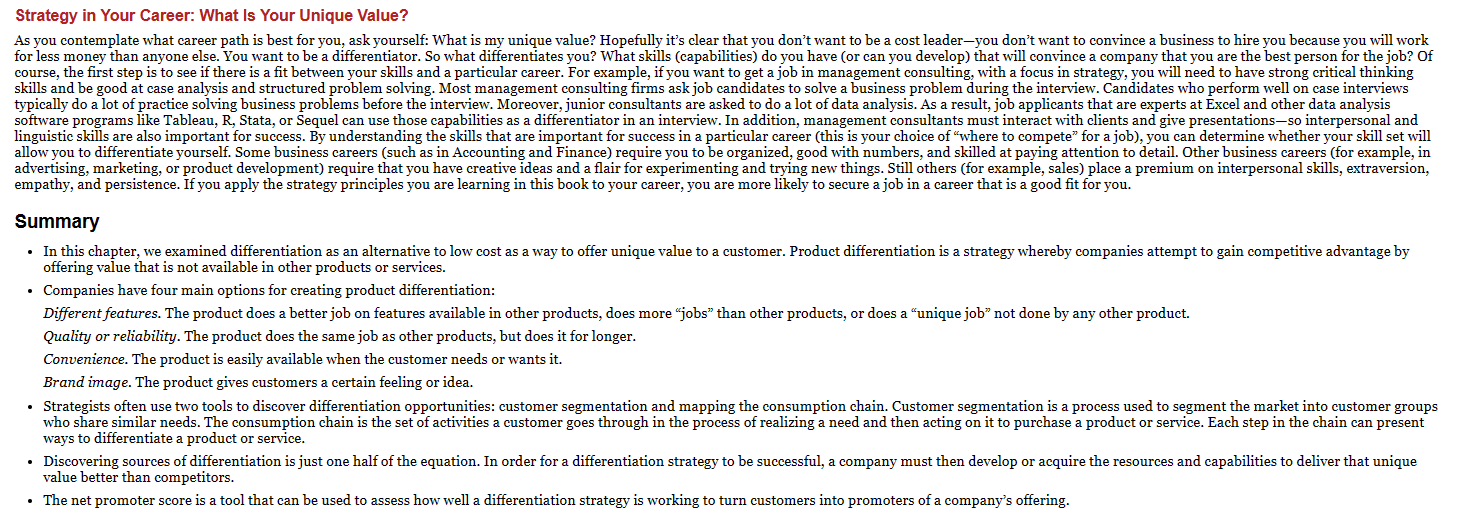
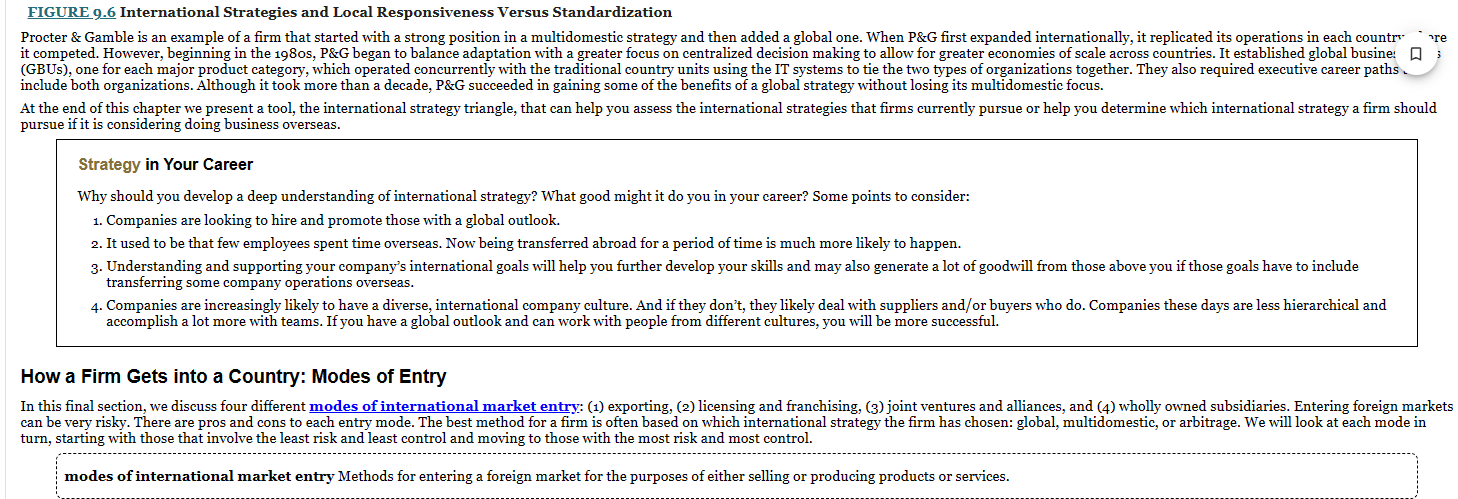

1. Do a SWOT analysis for yourself that relates to your goals. 2. List three SMART goals you have for your professional growth/personal life (see handout in a link in Unit 8 or read more about "SMART goals" on the internet). Note that SMART goals include timelines; some goals may have several steps/sub goals to be met on the way to the major goal. 1. For each goal, describe the importance of the goal, such as how meeting the goal will impact your career. 2. Write a detailed action plan including resources needed, networking, funding, etc. to meet the goals. The "Creating Line of Sight Measures" in Chapter 12, p. 228 of Dyer et al (2020) may be helpful. 3. Describe internal and external factors that may impact (positively and/or negatively) the achievement of your goals 4. Describe how you will measure progress toward meeting each of the goals. 3. Include at least one professional organization that you can join (many have student memberships at reduced prices; you may want to join now!). Explain the benefits of belonging and when you will join the organization. A S.M.A.R.T. goal is defined by its five key aspects or elements. Without all aspects, you might be goal setting, but not effectively creating a plan for success. Let's take a closer look at the five elements of S.M.A.R.T. goals. Specific Specific goals have a desired outcome that is clearly understood. This might be a sales number or a product rollout goal. No matter what it is, the goal should be clearly articulated so that everyone is on the same page with the objective. Define what will be accomplished and the actions to be taken to accomplish the goal. Measurable These are the numbers used with the goal. You need to have a quantifiable objective so that you can track progress. Define what data will be used to measure the goal and set a method for collection. Achievable Goals need to be realistic in order to maintain the enthusiasm to try to achieve them. Setting lofty goals is good, but you may want to break them down into smaller, bite-sized chunks. If the goal is not doable, you may need to first ramp up resources to give yourself a shot at success. Ramping up resources would likely be its own S.M.A.R.T. goal. Relevant Goals should be aligned with the mission of the company. Don't set goals just as an exercise for something to do. One way to determine if the goal is relevant is to define the key benefit to the organization. Time-Bound Goals should have a deadline. A goal without a deadline doesn't do much. How can you identify success or failure? This is why S.M.A.R.T. goals set a final date. This doesn't mean that all the work is done, but it means that you can evaluate the success of the endeavor and set new goals. Benefits of S.M.A.R.T. Goals There are a lot of benefits to setting S.M.A.R.T. goals, which is why you should consider adding them to your business toolbox. First, a S.M.A.R.T. goal helps to give you an objective. In doing this, you are able to identify strengths and weaknesses. Second, a S.M.A.R.T. goal provides motivation to succeed. When you know where the goal line is, you'll want to work to meet or beat it. Third, a good S.M.A.R.T. goal, while attainable, will also be challenging and force you out of your comfort zone. Ultimately, the S.M.A.R.T. goal is a useful tool to remain focused in attaining a goal. Gathering Data for the Competitive Advantage Pyramid Analysis Data to complete a pyramid come from a number of sources. You can use three main types of data: 1. Archival data: Written or numeric information can be found in the library or on the Internet. 2. Interviews: Interviews can range from personal questions to impersonal surveys. 3. Observation: Your own experiences, such as visits or use of products or services, are also valuable. Strategy and Your Career The competitive advantage pyramid provides a way for you to quickly document and understand a company's sources of competitive advantage, and it allows you to make some judgment about how durable and sustainable that advantage might be. As you approach decisions about where to work, you would be wise to invest the time and effort into creating a pyramid for each company you might like to work for. If you use the rigorous research methods described earlier in the chapter, you should be able to create an accurate and useful picture of the company. If you can do interviews or site visits, you may be able to create personal relationships that will give you good information and some positive recommenders within the company. The pyramid can help you prepare for interviews as well, as you'll be able to couch your answers in terms the company will value, and the pyramid tells you where to focus your research so you learn more about the company. The real value of the competitive advantage pyramid model in your job search, however, comes when you create one for yourself, or You, Inc. There is an end-of-chapter exercise that describes how you can create a personal pyramid. Take the time to collect data on your own activities, strengths, and weaknesses. You may get some uncomfortable feedback, but it will help you identify where you can add value. Catalog your resources and capabilities and think deeply about your core values and priorities. This deep level of the pyramid should help you clarify what you care about most, in your work and throughout your career. With a thoughtful personal pyramid, you can compare yours with those of target companies. You can identify areas, and jobs, where you may be able to create value for a company, and see where you can add to their resource base as well as grow your own. Finally, and most importantly, you can make sure that potential employers share your priorities and align with your values. These pyramids, both company and personal, can help you make better choices about where to work. If you want to create a pyramid profile for a private company, you might find very little archival data, but you may identify people willing to grant interviews or to directly observe the company's operations. For public companies, the reverse often proves true. Abundant archival data exist, but companies often create barriers, or firewalls, that make interviews difficult. The size of the company means that observations provide only a limited view of the company. The appendix helps you know what to look for as you perform a pyramid analysis and describes in detail different data sources you can use to do the analysis. As you gather data and use the questions to sort and categorize the information you find, remember the GIGO principle from computer programming: garbage in, garbage out. Stated more elegantly, the more attention you pa to gathering, verifying, and comparing the data, the richer, more robust, and more insightful your finished product will be. You should always rely on at least two types of data (e.g., archival records and interviews) and use multiple sources of data within each type. For each strength, weakness, resource, capability, value, or priority that you identify, include the source from which you drew your data. If your data all come from a single source suc. as a website or a Bloomberg Businessweek, Fortune, or Wall Street Journal article, then your pyramid will be weaker than if the information is drawn from multiple sources. Tapping other data sources, such as doing an interview or scheduling a plant visit, may seem daunting, but doing so will pay great dividends in creating a richer, more complete profile of the company. Be very careful to balance your data sources. Don't rely exclusively on data provided by the company or solely on data that come from the company's detractors. Both have a point of view that differs from the real company. If you are thinking about accepting a job with a company, or one of its competitors, you'll want to dedicate significant time and energy to developing the most accurate pyramid you can. Using the Competitive Advantage Pyramid You can use the pyramid to focus on a company's strengths or its weaknesses. It is often simpler to create a separate analysis for strengths and weaknesses as a first step. Table 3.1 shows the results of a simple pyramid analysis to compare the strengths of two national retailers: Walmart and Nordstrom. As you can see from the table, both Walmart and Nordstrom have clearly identifiable strengths that customers, suppliers, and others can readily see. empathy, and persistence. If you apply the strategy principles you are learning in this book to your career, you are more likely to secure a job in a career that is a good fit for you. Summary offering value that is not available in other products or services. - Companies have four main options for creating product differentiation: Different features. The product does a better job on features available in other products, does more "jobs" than other products, or does a "unique job" not done by any other product. Quality or reliability. The product does the same job as other products, but does it for longer. Convenience. The product is easily available when the customer needs or wants it. Brand image. The product gives customers a certain feeling or idea. ways to differentiate a product or service. value better than competitors. - The net promoter score is a tool that can be used to assess how well a differentiation strategy is working to turn customers into promoters of a company's offering. FIGURE 9.6 International Strategies and Local Responsiveness Versus Standardization include both organizations. Although it took more than a decade, P\&G succeeded in gaining some of the benefits of a global strategy without losing its multidomestic focus. pursue if it is considering doing business overseas. Strategy in Your Career Why should you develop a deep understanding of international strategy? What good might it do you in your career? Some points to consider: 1. Companies are looking to hire and promote those with a global outlook. 2. It used to be that few employees spent time overseas. Now being transferred abroad for a period of time is much more likely to happen. transferring some company operations overseas. accomplish a lot more with teams. If you have a global outlook and can work with people from different cultures, you will be more successful. How a Firm Gets into a Country: Modes of Entry turn, starting with those that involve the least risk and least control and moving to those with the most risk and most control. modes of international market entry Methods for entering a foreign market for the purposes of either selling or producing products or services. How to Use Line of Sight to Advance Your Career advantage, or to deepen the firm's resources and capabilities? your organization. They'll pay you more, promote you, and work to keep you employed. This may be spending time learning spreadsheet or data analytics skills, or it may involve volunteering at a local non-profit. 1. Do a SWOT analysis for yourself that relates to your goals. 2. List three SMART goals you have for your professional growth/personal life (see handout in a link in Unit 8 or read more about "SMART goals" on the internet). Note that SMART goals include timelines; some goals may have several steps/sub goals to be met on the way to the major goal. 1. For each goal, describe the importance of the goal, such as how meeting the goal will impact your career. 2. Write a detailed action plan including resources needed, networking, funding, etc. to meet the goals. The "Creating Line of Sight Measures" in Chapter 12, p. 228 of Dyer et al (2020) may be helpful. 3. Describe internal and external factors that may impact (positively and/or negatively) the achievement of your goals 4. Describe how you will measure progress toward meeting each of the goals. 3. Include at least one professional organization that you can join (many have student memberships at reduced prices; you may want to join now!). Explain the benefits of belonging and when you will join the organization. A S.M.A.R.T. goal is defined by its five key aspects or elements. Without all aspects, you might be goal setting, but not effectively creating a plan for success. Let's take a closer look at the five elements of S.M.A.R.T. goals. Specific Specific goals have a desired outcome that is clearly understood. This might be a sales number or a product rollout goal. No matter what it is, the goal should be clearly articulated so that everyone is on the same page with the objective. Define what will be accomplished and the actions to be taken to accomplish the goal. Measurable These are the numbers used with the goal. You need to have a quantifiable objective so that you can track progress. Define what data will be used to measure the goal and set a method for collection. Achievable Goals need to be realistic in order to maintain the enthusiasm to try to achieve them. Setting lofty goals is good, but you may want to break them down into smaller, bite-sized chunks. If the goal is not doable, you may need to first ramp up resources to give yourself a shot at success. Ramping up resources would likely be its own S.M.A.R.T. goal. Relevant Goals should be aligned with the mission of the company. Don't set goals just as an exercise for something to do. One way to determine if the goal is relevant is to define the key benefit to the organization. Time-Bound Goals should have a deadline. A goal without a deadline doesn't do much. How can you identify success or failure? This is why S.M.A.R.T. goals set a final date. This doesn't mean that all the work is done, but it means that you can evaluate the success of the endeavor and set new goals. Benefits of S.M.A.R.T. Goals There are a lot of benefits to setting S.M.A.R.T. goals, which is why you should consider adding them to your business toolbox. First, a S.M.A.R.T. goal helps to give you an objective. In doing this, you are able to identify strengths and weaknesses. Second, a S.M.A.R.T. goal provides motivation to succeed. When you know where the goal line is, you'll want to work to meet or beat it. Third, a good S.M.A.R.T. goal, while attainable, will also be challenging and force you out of your comfort zone. Ultimately, the S.M.A.R.T. goal is a useful tool to remain focused in attaining a goal. Gathering Data for the Competitive Advantage Pyramid Analysis Data to complete a pyramid come from a number of sources. You can use three main types of data: 1. Archival data: Written or numeric information can be found in the library or on the Internet. 2. Interviews: Interviews can range from personal questions to impersonal surveys. 3. Observation: Your own experiences, such as visits or use of products or services, are also valuable. Strategy and Your Career The competitive advantage pyramid provides a way for you to quickly document and understand a company's sources of competitive advantage, and it allows you to make some judgment about how durable and sustainable that advantage might be. As you approach decisions about where to work, you would be wise to invest the time and effort into creating a pyramid for each company you might like to work for. If you use the rigorous research methods described earlier in the chapter, you should be able to create an accurate and useful picture of the company. If you can do interviews or site visits, you may be able to create personal relationships that will give you good information and some positive recommenders within the company. The pyramid can help you prepare for interviews as well, as you'll be able to couch your answers in terms the company will value, and the pyramid tells you where to focus your research so you learn more about the company. The real value of the competitive advantage pyramid model in your job search, however, comes when you create one for yourself, or You, Inc. There is an end-of-chapter exercise that describes how you can create a personal pyramid. Take the time to collect data on your own activities, strengths, and weaknesses. You may get some uncomfortable feedback, but it will help you identify where you can add value. Catalog your resources and capabilities and think deeply about your core values and priorities. This deep level of the pyramid should help you clarify what you care about most, in your work and throughout your career. With a thoughtful personal pyramid, you can compare yours with those of target companies. You can identify areas, and jobs, where you may be able to create value for a company, and see where you can add to their resource base as well as grow your own. Finally, and most importantly, you can make sure that potential employers share your priorities and align with your values. These pyramids, both company and personal, can help you make better choices about where to work. If you want to create a pyramid profile for a private company, you might find very little archival data, but you may identify people willing to grant interviews or to directly observe the company's operations. For public companies, the reverse often proves true. Abundant archival data exist, but companies often create barriers, or firewalls, that make interviews difficult. The size of the company means that observations provide only a limited view of the company. The appendix helps you know what to look for as you perform a pyramid analysis and describes in detail different data sources you can use to do the analysis. As you gather data and use the questions to sort and categorize the information you find, remember the GIGO principle from computer programming: garbage in, garbage out. Stated more elegantly, the more attention you pa to gathering, verifying, and comparing the data, the richer, more robust, and more insightful your finished product will be. You should always rely on at least two types of data (e.g., archival records and interviews) and use multiple sources of data within each type. For each strength, weakness, resource, capability, value, or priority that you identify, include the source from which you drew your data. If your data all come from a single source suc. as a website or a Bloomberg Businessweek, Fortune, or Wall Street Journal article, then your pyramid will be weaker than if the information is drawn from multiple sources. Tapping other data sources, such as doing an interview or scheduling a plant visit, may seem daunting, but doing so will pay great dividends in creating a richer, more complete profile of the company. Be very careful to balance your data sources. Don't rely exclusively on data provided by the company or solely on data that come from the company's detractors. Both have a point of view that differs from the real company. If you are thinking about accepting a job with a company, or one of its competitors, you'll want to dedicate significant time and energy to developing the most accurate pyramid you can. Using the Competitive Advantage Pyramid You can use the pyramid to focus on a company's strengths or its weaknesses. It is often simpler to create a separate analysis for strengths and weaknesses as a first step. Table 3.1 shows the results of a simple pyramid analysis to compare the strengths of two national retailers: Walmart and Nordstrom. As you can see from the table, both Walmart and Nordstrom have clearly identifiable strengths that customers, suppliers, and others can readily see. empathy, and persistence. If you apply the strategy principles you are learning in this book to your career, you are more likely to secure a job in a career that is a good fit for you. Summary offering value that is not available in other products or services. - Companies have four main options for creating product differentiation: Different features. The product does a better job on features available in other products, does more "jobs" than other products, or does a "unique job" not done by any other product. Quality or reliability. The product does the same job as other products, but does it for longer. Convenience. The product is easily available when the customer needs or wants it. Brand image. The product gives customers a certain feeling or idea. ways to differentiate a product or service. value better than competitors. - The net promoter score is a tool that can be used to assess how well a differentiation strategy is working to turn customers into promoters of a company's offering. FIGURE 9.6 International Strategies and Local Responsiveness Versus Standardization include both organizations. Although it took more than a decade, P\&G succeeded in gaining some of the benefits of a global strategy without losing its multidomestic focus. pursue if it is considering doing business overseas. Strategy in Your Career Why should you develop a deep understanding of international strategy? What good might it do you in your career? Some points to consider: 1. Companies are looking to hire and promote those with a global outlook. 2. It used to be that few employees spent time overseas. Now being transferred abroad for a period of time is much more likely to happen. transferring some company operations overseas. accomplish a lot more with teams. If you have a global outlook and can work with people from different cultures, you will be more successful. How a Firm Gets into a Country: Modes of Entry turn, starting with those that involve the least risk and least control and moving to those with the most risk and most control. modes of international market entry Methods for entering a foreign market for the purposes of either selling or producing products or services. How to Use Line of Sight to Advance Your Career advantage, or to deepen the firm's resources and capabilities? your organization. They'll pay you more, promote you, and work to keep you employed. This may be spending time learning spreadsheet or data analytics skills, or it may involve volunteering at a local non-profit












